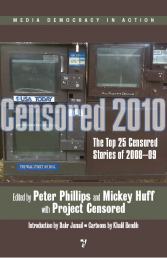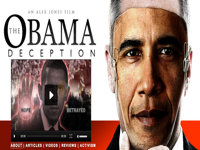Posts Tagged ‘information’
Source:
TomDispatch.com, September 19, 2006
Author: Mike Davis
Title: “Border Invaders: The Perfect Swarm Heads South”
http://www.tomdispatch.com/index.mhtml?pid=122537
Student Researcher: Rachel Icaza and Erica Haikara
Faculty Evaluator: Francisco Vazquez, Ph.D.
The visitor crossing the Mexican border from Tijuana to San Diego these days is immediately confronted by a huge sign, “Stop the Border Invasion!” Sponsored by allies of the anti-immigrant vigilante group, the Minutemen, the same signs insult Mexican citizens at other border crossings in Arizona and Texas. The ultimate irony is that a crisis invasion is indeed occurring, but the signs, it seems, may be pointed the wrong direction.
Author Mike Davis points out that, in a “reality stood on its head,” few people—at least outside Mexico—have bothered to notice that while all the nannies, cooks, maids, and gardeners have been heading north to tend the luxury lifestyles of irate republicans, the Gringo masses have been rushing south to enjoy glorious budget retirements and affordable second homes in Mexico.
The number of North Americans living in Mexico has soared from 200,000 to 1 million (one-quarter of all US expatriates) in the past decade. With more than 70 million American baby-boomers expected to retire in the next two decades, experts predict “a tidal wave” of migration to warmer—and cheaper—climates. Baby-boomers are not simply feathering nests for eventual retirement, but also increasingly speculating in Mexican resort property and gated communities, complete with Hooters, Burger King, and Starbucks. The land rush is sending up property values to the detriment of locals whose children are consequently driven into slums or forced to emigrate north, only to face increasing “invasion” charges.
The Gringo footprint is largest (and brings the most significant geopolitical consequences) in Baja California, an epochal process that, if unchecked, will produce intolerable social marginalization and ecological devastation.
Indeed, the first two stages of informal annexation have already occurred. Under the banner of NAFTA, Southern California has exported hundreds of its sweatshops and toxic industries to the maquiladora zones of Tijuana and Mexicali. The Pacific Maritime Association, representing the West Coast’s major shipping companies, has joined forces with Korean and Japanese corporations to explore the construction of a vast new container port at Punta Colonel, 150 miles south of Tijuana, which would undercut the power of Longshore unionism in San Pedro and San Francisco.
Secondly, tens of thousands of US retirees and winter-residents are now clustered at both ends of the peninsula. Along the northwest coast from Tijuana to Ensenada, a recent advertisement for a real estate conference at UCLA boasts that “there are presently over fifty-seven real estate developments with over 11,000 homes/condos with an inventory value of over $3 billion all of them geared for the US market.”
Meanwhile, at the tropical end of Baja, a US expatriot enclave has emerged in the twenty-mile strip between Cabo San Lucas and San Jose de Cabo. Los Cabos has become an archipelago of real-estate hot spots where continuous double-digit increases in property values pull in speculative capital. Judging from the registration of private planes at the local airport, Cabos has essentially become a resort suburb of Orange County—the home of the most vehement Minutemen chapters.
Davis points out that many wealthy Southern Californians evidently see no contradiction between fuming over the “alien invasion” with one’s conservative friends at the Newport Marina one day, and flying down to enjoy their Cabos investment properties the next.
One of several multi-billion dollar real estate projects being developed for the US market is the Villages of Loreto: another 6,000 homes for expatriates in colonial-Mexico motif on the Sea of Cortez. The $3 billion Loreto project boasts that it will be the last word in green design, exploiting solar power and restricting automobile usage. It will, coincidently, balloon Loreto’s population from its current 15,000 to more than 100,000 in a decade, with the social and environmental consequences of a sort that can already be seen in the slum peripheries of Cancun and other mega-resorts.
One of the irresistible attractions of Baja is that it has preserved a primordial wildness that has disappeared elsewhere in the West. Local residents, including a very eloquent indigenous environmental movement, cherish this incomparable landscape, as they do the survival of an egalitarian ethos in the peninsula’s small towns and fishing villages.
However, thanks to the silent invasion of the baby-boomers from the north, much of the natural history and frontier culture of Baja could be swept away in the next generation. The problem is, as Tom Engelhardt of Tomdispatch points out, “Fences don’t work if you’ve got your own plane.”
 press-freedom, liberties, information, politics, news, life, censorship, top-25, mexico, usa
press-freedom, liberties, information, politics, news, life, censorship, top-25, mexico, usa
Sources:
Global Research, January 20, 2007
Title: “Wiped Off The Map—The Rumor of the Century”
Author: Arash Norouzi
http://www.globalresearch.ca/index.php?context=viewArticle&code=NOR20070120&articleId=4527
Information Clearing House, May 9, 2006
Title: “Full Text: The President of Iran’s Letter To President Bush”
Translated by Le Monde
http://www.informationclearinghouse.info/article12984.htm
Student Researchers: Becky Bazell
Faculty Evaluator: Peter Phillips, Ph.D.
Across the world a media story has spread that Iran’s President Ahmadinejad has threatened to destroy Israel, by saying that, “Israel must be wiped off the map.” Contrary to general belief, this statement was actually a misinterpretation. However, it was the Islamic Republic News Service in Iran that first mistranslated the quote. Iran’s Foreign Minister attempted to clarify the statement, but the quote ended up having a life of its own in the corporate media.
Amid heated wrangling over Iran’s nuclear program and the threat of preemptive strikes by the US, the quote has been continually used to reinforce the idea that Iran is being run by extremists seeking the total destruction of Israel.
So what did Ahmadinejad actually say? To quote his exact words in Farsi:
“Imam ghoft een rezhim-e ishghalgar-e qods bayad az safheh-ye ruzgar mahv shavad.”
Rezhim-e is the word “regime,” pronounced just like the English word with an extra “eh” sound at the end. Ahmadinejad did not refer to Israel the country or Israel the landmass, but the Israeli regime. This is a vastly significant distinction, as one cannot wipe a regime off the map. Ahmadinejad did not even refer to Israel by name, he instead used the specific phrase “rezhim-e ishghalgar-e qods” (regime occupying Jerusalem).
A similar statement by Ahmadinejad in December 2006, “As the Soviet Union disappeared, the Zionist regime will also vanish and humanity will be liberated,” has also been misinterpreted.
In May of 2006 President Ahmadinejad published an open letter to President Bush clearly asking for peace and the mutual respect of human rights. He warns that Western media, through contrived and deceptive information, has intensified the climate of fear that leads to attacks on innocent peoples. The letter was not reported in the US news media. Ahmadinejad began the letter writing, “Mr. George Bush, For some time now I have been thinking, how one can justify the undeniable contradictions that exist in the international arena. Can one be a follower of Jesus Christ (PBUH), the great Messenger of God, Feel obliged to respect human rights, Present liberalism as a civilization model, Announce one’s opposition to the proliferation of nuclear weapons and WMDs, Make “War on Terror” his slogan, And finally, Work towards the establishment of a unified international community—a community which Christ and the virtuous of the Earth will one day govern, But at the same time, have countries attacked; The lives, reputations and possessions of people destroyed and on the slight chance of the … of a … criminals in a village city, or convoy for example the entire village, city or convey set ablaze.”
Evaluator Comment
Ahmadinejad declared that Zionism is the West’s apparatus of political oppression against Muslims. He says the “Zionist regime” was imposed on the Islamic world as a strategic bridgehead to ensure domination of the region and its assets. This position is viewed as threatening to many in the West. While threats and counter-threats escalates tensions in the Persian Gulf, I believe it is important for the media to publish both sides of issues and be as accurate as possible by seeking to build understanding rather than fear and anger.
—Peter Phillips
UPDATE BY Arash Norouzi
In May 2007, the US House of Representatives unanimously passed a resolution calling on the U.N. Security Council to charge Ahmadinejad with the crime of inciting genocide “because of his calls for the destruction of the State of Israel”—a violation of the U.N.’s 1948 Genocide Convention—specifically citing the false “wiped off the map” quote from October 2005. It also called for the U.N. to prevent Iran from obtaining nuclear weapons, with the “potential means to the end of carrying out President Mahmoud Ahmadinejad’s threats against Israel.”
This misquote has become a key component of the push for war with Iran, a war that would make Iraq look like the cakewalk it was predicted to be. Attacking Iran would result in massive death and destruction, affect world oil supplies, provoke terrorism, could initiate the next World War, and might even include the use of nuclear weapons for the first time since WWII. In this heated atmosphere, an accurate narrative is essential in averting the next cataclysmic Mideast intervention. When President Bush emphasizes the importance of taking the words of America’s enemies seriously, that process begins with first determining just what exactly those words are.
Yet my article is about more than just clarifying a mistranslated statement. It’s about the media, propaganda, plagiarism, language, false assumptions …Functioning much like a puzzle, it engages readers by allowing them to deconstruct the quote and its meaning themselves. This self-verification process adds a compelling aspect in which credibility becomes largely obsolete. The article’s ’punchline’ demonstrates undeniably that members of the mainstream media knowingly spread this rumor, and readers are challenged to check for themselves by comparing linked sources proving this claim.
The idea is not merely to contest a single misquote, but to also promote skepticism about all pre-war intelligence. If this quote is false, then it’s logical to assume that other accusations against Iran could be wrong too—just as they were with Iraq.
The overwhelming ubiquity of this misquote has deterred others from correcting what they probably view as a lost cause. Yet my article alone has been viewed by millions, translated into at least half a dozen languages, garnered radio interviews, inspired videos on YouTube, and become the subject of an entire article in The Bangkok Post. It got the attention of people at the BBC, Washington Post, IAEA, State Department, United Nations, and the Islamic Republic itself. It’s been quoted by numerous journalists, authors and academics, in published letters to the editor, and on call-in TV shows such as on C-SPAN. The Associated Press has now begun citing the “vanish from the page of time” phrase, adding that “independent analysts” have refuted the “map” quote; and Dennis Kucinich was prepared to correct the rumor when asked about the subject on TV recently.
These are hopeful signals that underscore the importance of alternative voices in the media, and their potential effectiveness in influencing the discourse. If the first casualty of war is the truth, then it’s up to the truth tellers—whomever they may be—to enlighten us.
 press-freedom, liberties, information, politics, news, life, censorship, top-25, energy, nuclear, iran
press-freedom, liberties, information, politics, news, life, censorship, top-25, energy, nuclear, iran
Source:
LiP Magazine, June 5, 2006
Title: “Native Energy Futures”
Author: Brian Awehali
http://www.lipmagazine.org/articles/featawehali_nativefutures.htm
Student Researchers: Ioana Lupu and Mayra Madrigal
Faculty Evaluator: Dolly Freidel, Ph.D.
Energy on Native American land is becoming big business. According to the Indigenous Environmental Network, 35 percent of the fossil fuel resources in the US are within Indian country. The Department of the Interior estimates that Indian lands hold undiscovered reserves of almost 54 billion tons of coal, 38 trillion cubic feet of natural gas, and 5.4 billion barrels of oil. Tribal lands also contain enormous amounts of alternative energy. “Wind blowing through Indian reservations in just four northern Great Plains states could support almost 200,000 megawatts of wind power,” Winona LaDuke told Indian Country Today in March 2005, “Tribal landholdings in the southwestern US…could generate enough power to eradicate all fossil fuel burning power plants in the US.”
The questions to be answered now are: what sort of energy will Indian lands produce, who will make that decision, and who will end up benefiting from the production?
According to Theresa Rosier, Counselor to the Assistant Secretary for Indian Affairs, “increased energy development in Indian and Alaska Native communities could help the Nation have more reliable homegrown energy supplies.” This, she says, is “consistent with the President’s National Energy Policy to secure America’s energy future.”
Rosier’s statement conveys quite a lot about how the government and the energy sector intend to market the growing shift away from dependence on foreign energy. The idea that “America’s energy future” should be linked to having “more reliable homegrown energy supplies” can be found in native energy-specific legislation that has already passed into law. What this line of thinking fails to take into account is that Native America is not the same as US America. The domestic “supplies” in question belong to sovereign nations, not to the United States or its energy sector.
So far, government plans to deregulate and step up the development of domestic (native) energy resources is being spun as a way to produce clean, efficient energy while helping Native Americans gain greater economic and tribal sovereignty. Critics charge, however, that large energy companies are simply looking to establish lucrative partnerships with tribal corporations, which are largely free of regulation and federal oversight.
For example, in 2003, the Rosebud Sioux of South Dakota, in partnership with NativeEnergy, LLC, completed the first large-scale native-owned wind turbine in history. The project was billed as a way to bring renewable energy–related jobs and training opportunities to the citizens of this sovereign nation, who are among the poorest in all of North America.
NativeEnergy’s President and CEO Tom Boucher, an energy industry vet, financed the Rosebud Sioux project by selling “flexible emissions standards” created by the Kyoto Protocol. These are the tax-deductible pollution credits from ecologically responsible companies (or in this case, Native American tribes), which can then be sold to polluters wishing to “offset” their carbon dioxide generation without actually reducing their emissions.
Since the Rosebud test case proved successful, NativeEnergy moved forward with plans to develop a larger “distributed wind project,” located on eight different reservations. NativeEnergy also became a majority Indian-owned company in August 2005, when the pro-development Intertribal Council on Utility Policy (COUP) purchased a majority stake in the company on behalf of its member tribes.
The COUP-NativeEnergy purchase just happened to coincide with the passage of the 2005 Energy Policy Act. The act contains a number of native energy–specific provisions in its Title V, many of which set alarming precedents.
Most outrageously, it gave the US government the power to grant rights of way through Indian lands without permission from the tribes—if deemed to be in the strategic interests of an energy-related project. Under the guise of “promoting tribal sovereignty,” the act also released the federal government from liability with regard to resource development, shifting responsibility for environmental review and regulation from the federal to tribal governments. Also, according to the Indigenous Environmental Network, the act “rolls back the protections of…critical pieces of legislation that grassroots indigenous peoples utilize to protect our sacred sites.” Some critics have derided the 2005 act as a fire sale on Indian energy, characterizing various incentives as a broad collection of subsidies (federal handouts) for US energy companies.
America’s native peoples may attain a modicum of energy independence and tribal sovereignty through the development of wind, solar, and other renewable energy infrastructure on their lands. But, according to Brian Awehali, it won’t come from getting into bed with, and becoming indebted to, the very industry currently driving the planet to its doom.
UPDATE BY Brian Awehali
I believe the topic of this article was important and urgent because sometimes all that glitters really is gold, even if the marketing copy says it’s green. The long and utterly predictable history where indigenous peoples and US government and corporate interests are both concerned shouldn’t be forgotten as we enter the brave new green era. Marketing for-profit energy schemes on Indian lands as a means of promoting tribal sovereignty is both ludicrous and offensive, as are “green” development plans intrinsically tied to the extraction of fossil fuels in the deregulated Wild West of Indian Country. Energy companies are only interested in native sovereignty because it means operations on Indian lands are not subject to federal regulation or oversight. This is why I included a discussion in my article about the instructive example of the Alaska tribal corporations and the ways they’ve mutated into multi-billion dollar loophole exploiters. (My brief examination of Alaska tribal corporations drew heavily from an excellent Mother Jones article, “Little Big Companies,” by Michael Scherer). It’s also my belief that the probably well-intentioned idea of “green tags,” carbon offset credits, and market-enabled “carbon neutrality” should be examined very closely: Why are we introducing systems for transferring (or trading) the carbon emissions of “First World” polluters to those who contributed least to global warming? I would argue that this is merely a nice-sounding way for the overdeveloped world to purchase the right to continue its pathologically unsustainable mode of existence, while doing little to address the very grave ecological realities we now face.
It’s very hard to know what the impact of this story was, or to gauge mainstream response to it. In my experience, the so-called mainstream has a difficult time absorbing and understanding Native American issues, not least because this mainstream tends to think of indigenous peoples in North America in historical, rather than contemporary, terms. I am, however, encouraged by the number of journalists and writers who are beginning to ask critical questions about greenwashing, and I see my story as adding to that collective body of work.
For more information about energy policy and its impact on indigenous communities of North America, I recommend visiting the Indigenous Environmental Network (http://www.ienearth.org), and checking out their Native Energy Campaign.
 press-freedom, liberties, information, politics, news, life, censorship, top-25, energy, pollution, natives
press-freedom, liberties, information, politics, news, life, censorship, top-25, energy, pollution, natives




 E-mail Subscribe
E-mail Subscribe


































